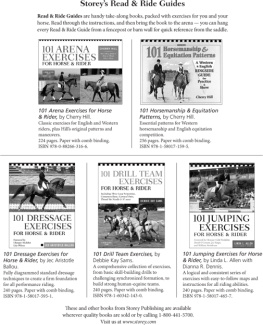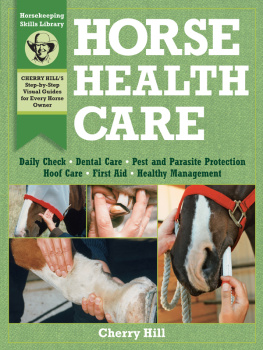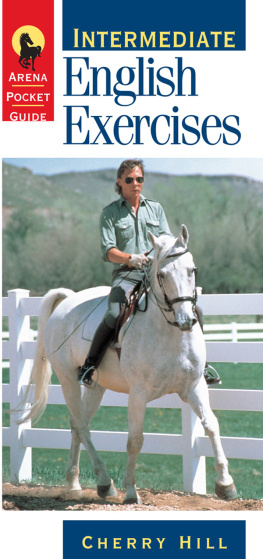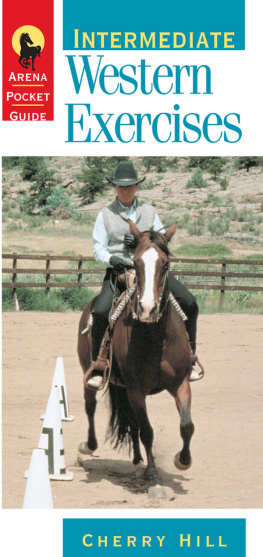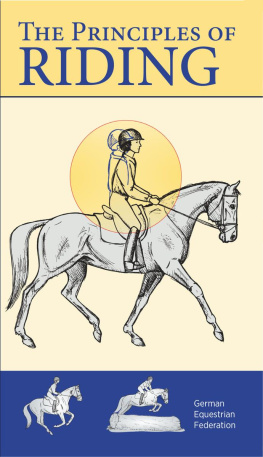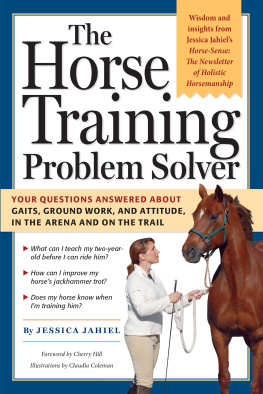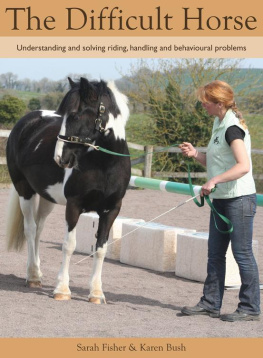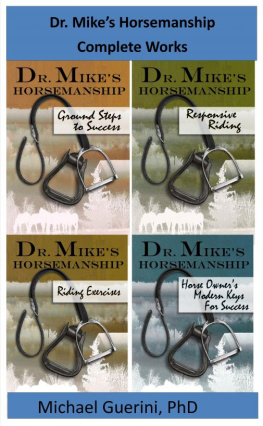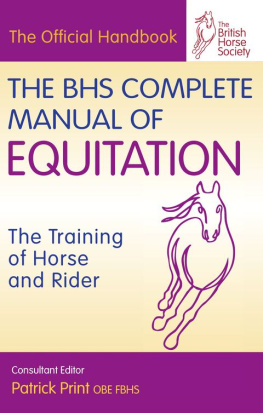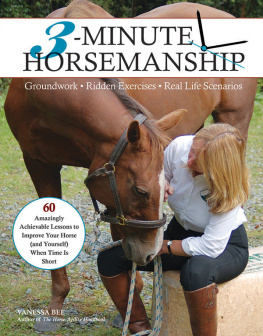101 Ground Training Exercises
for Every Horse & Handler
Cherry Hill

The mission of Storey Publishing is to serve our customers by publishing practical information that encourages personal independence in harmony with the environment.
Edited by Deborah Burns and Lisa H. Hiley
Art direction and book design by Cynthia N. McFarland
Cover photography by Dusty Perin
Interior photography by Richard Klimesh and Cherry Hill
Illustrations by Elayne Sears
Arena diagrams by Ilona Sherratt
Indexed by Susan Olason
2012 by Cherry Hill
All rights reserved. No part of this book may be reproduced without written permission from the publisher, except by a reviewer who may quote brief passages or reproduce illustrations in a review with appropriate credits; nor may any part of this book be reproduced, stored in a retrieval system, or transmitted in any form or by any means electronic, mechanical, photocopying, recording, or other without written permission from the publisher.
The information in this book is true and complete to the best of our knowledge. All recommendations are made without guarantee on the part of the author or Storey Publishing. The author and publisher disclaim any liability in connection with the use of this information.
Storey books are available for special premium and promotional uses and for customized editions. For further information, please call 1-800-793-9396.
Storey Publishing
210 MASS MoCA Way
North Adams, MA 01247
www.storey.com
Printed in the United States by Versa Press
10 9 8 7 6 5 4 3 2 1
LIBRARY OF CONGRESS CATALOGING-IN-PUBLICATION DATA on file

To Seeker, the model for
many of the illustrations in
this book. I miss you, girl.
CONTENTS
INTRODUCTION
Horses are always learning. Everything you do with your horse is training. Whenever you interact with your horse, if you are not riding, you are ground training. As you feed, halter, or turn your horse out on pasture, you might not be thinking of these things as lessons, but you can bet your horse is forming habits, good or bad.
The master goals of ground training are to develop respect, trust, and willingness. The objective, measurable goals for different exercises are also important, but one must always ensure that the three subjective master goals are being met. Expression and attitude should be measured along with mechanics. If a horse is respectful, trusting, and willing, the mechanics will follow.
Ground training is valuable for many reasons.
First of all, it is part of a progressive education for your horse that will make him confident and well rounded. A thorough ground-training program will be the basis for the two of you to develop a good working partnership.
Safety is essential for both you and your horse. A step-by-step ground-training program will help your lessons progress calmly and smoothly. Begin by teaching your horse simple things. Require that he do those simple things well. Then gradually and progressively add more difficulty to the lessons. In this way you never frighten, surprise, or overly challenge your horse. You set things up for success so that he can take the new lesson in stride. There are very few mishaps, blowups, or fear reactions. Things move forward safely in a progression that develops confidence.
Good ground training will segue seamlessly into mounted training. The habits you help your horse form in the early stages will last a lifetime. Thats why it is important to take the time it takes. Dont be in a hurry or think that ground training is inconsequential. Be patient and develop patience in your horse.
Many ground-training exercises develop flexibility, balance, and muscular coordination. In that way, they can be thought of as part gymnastics and part dancing a valuable tool for physical development and conditioning and a graceful way for the two of you to work together on the ground.
Using a system to train an animal is sensible and reliable, just as it is to educate children. A system provides the opportunity to review previous lessons when you encounter problems. Ground training can even be used to keep your horse in work during a period when you might not be able to ride.
Since ground training is such a key element in your horses total program, it is essential to be diligent, devoted to your goal, and consistent with your body language, cues, and manner.
ABC: Always Be Conscious of what you are doing with a horse.

PART 1
LAYING THE GROUNDWORK

One of the first things a horse must become accustomed to is people approaching him, moving around him, and being nearby in various positions. With any horse, but particularly one that you are just beginning to work with, it is important to move and behave in a manner that makes him feel comfortable. This means moving slowly, quietly, and with purpose. Once a horse accepts that you are trustworthy, you can begin adding variations in position and movement that will broaden his confidence and experience.
Since horses dont communicate verbally the way we do, they rely on a highly developed combination of sensory inputs to read what is happening around them. Their senses of smell, hearing, and touch give them much information about what is going on. Horses are more capable of reading your mood and intent than you may realize. Thats why its so important to be in a positive, nonthreatening frame of mind when you approach and work with your horse. No matter how perfectly you have mastered your skills and aids, if you are angry, impatient, irritated, or just plain ill-tempered, your horse will probably sense it and might react with anxiety, apprehension, or fear.
Assuming you are the positive leader a horse needs and that you can reliably read the signals he is giving you, the next thing you need to be aware of is your own body language. What you do, how you do it, and when you do it will have a great effect on your horses reactions.
A horse wants a leader more than a friend.
First Things First
This chapter covers the nuts and bolts of ground training, so be sure to read it before you begin, and refer to it frequently as you progress through the exercises. The exercises are grouped by categories but are not necessarily listed in the order you will use them. Every horses temperament and experiences are different, so youll need to tailor the order of your program to each horse you work with. A horse will tell you what lesson he needs next. When in doubt about where to start with a particular horse, begin at what appears to be square one for that horse and use it as a chance to observe and evaluate him.
For example, your horse might already be halter trained, in which case you have already mastered Exercise 1: Approaching to Catch. If not, you can start there. If so, you can move to Exercise 2: Haltering. But if you have determined that haltering would be too restrictive for a particular horse until he learns to yield, you might want to work on the Free Longe exercises in : Learning to Yield before you halter him.

